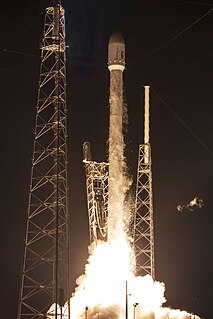Related Research Articles

SSL, formerly Space Systems/Loral, LLC (SS/L), of Palo Alto, California, is a wholly owned manufacturing subsidiary of Maxar Technologies.

A CubeSat is a class of miniaturized satellite based around a form factor consisting of 10 cm (3.9 in) cubes. CubeSats have a mass of no more than 2 kg (4.4 lb) per unit, and often use commercial off-the-shelf (COTS) components for their electronics and structure. CubeSats are put into orbit by deployers on the International Space Station, or launched as secondary payloads on a launch vehicle. As of August 2021, more than 1,600 CubeSats have been launched.

A small satellite, miniaturized satellite, or smallsat is a satellite of low mass and size, usually under 1,200 kg (2,600 lb). While all such satellites can be referred to as "small", different classifications are used to categorize them based on mass. Satellites can be built small to reduce the large economic cost of launch vehicles and the costs associated with construction. Miniature satellites, especially in large numbers, may be more useful than fewer, larger ones for some purposes – for example, gathering of scientific data and radio relay. Technical challenges in the construction of small satellites may include the lack of sufficient power storage or of room for a propulsion system.

FalconSAT is the United States Air Force Academy's (USAFA) small satellite engineering program. Satellites are designed, built, tested, and operated by Academy cadets. The project is administered by the USAFA Space Systems Research Center under the direction of the Department of Astronautics. Most of the cadets who work on the project are pursuing a bachelor of science degree in astronautical engineering, although students from other disciplines join the project.

TopSat is a British Earth observation satellite, currently in Low Earth Orbit. The nanosatellite was launched in October 2005 alongside the Beijing-1 Disaster Monitoring Constellation satellite by a Cosmos rocket from Plesetsk Cosmodrome in Russia.

SpaceQuest, Ltd. is a spacecraft components and engineering company located in Fairfax, Virginia, which focuses on the operations of small satellites.

TacSat-2 is the first in a series of U.S. military experimental technology and communication satellites.TacSat-2 (also known as JWS-D1 was an experimental satellite built by the USAF's Air Force Research Laboratory with an operational life expected to be not more than one year as part of the "Advanced Concept Technology Demonstration" program.

TacSat-3 is the second in a series of U.S. military experimental technology and communication satellites. It was assembled in an Air Force Research Laboratory (AFRL) Space Vehicles Directorate facility at Kirtland Air Force Base, New Mexico. The TacSat satellites are all designed to demonstrate the ability to provide real-time data collected from space to combatant commanders in the field.

A satellite bus is the main body and structural component of the satellite in which the payload and all scientific instruments are held.
UK-DMC 2 is a British Earth imaging satellite which is operated by DMC International Imaging. It was constructed by Surrey Satellite Technology, based on the SSTL-100 satellite bus. It is part of Britain's contribution to the Disaster Monitoring Constellation, which is coordinated by DMC International Imaging. It is the successor to the UK-DMC satellite.
ITUpSAT1, short for Istanbul Technical University picoSatellite-1) is a single CubeSat built by the Faculty of Aeronautics and Astronautics at the Istanbul Technical University. It was launched on 23 September 2009 atop a PSLV-C14 satellite launch vehicle from Satish Dhawan Space Centre, Sriharikota, Andhra Pradesh in India, and became the first Turkish university satellite to orbit the Earth. It was expected to have a minimum of six-month life term, but it is still functioning for over two years. It is a picosatellite with side lengths of 10 centimetres (3.9 in) and a mass of 0.990 kilograms (2.18 lb).
RASAT is an earth observation satellite designed and developed by TÜBİTAK Space Technologies Research Institute and produced in Turkey to provide high resolution imagery. It is so the first one of its art completely realized in Turkey, and the second indigenously developed remote sensing satellite after BILSAT-1.

PhoneSat is an ongoing NASA project of building nanosatellites using unmodified consumer-grade off-the-shelf smartphones and Arduino platform and launching them into Low Earth Orbit. This project is part of NASA's Small Spacecraft Technology Program and was started in 2009 at NASA Ames Research Center.
iCube-1 is a miniaturised satellite built by the Institute of Space Technology in Pakistan, with an objective to provide a wide range of future experiments in the domain of imaging, microgravity, biology, nanotechnology, space dynamics, chemistry, space physics and various other fields. It can also provide a testbed for developing satellite constellations for specific applications.

AsiaSat 6 / Thaicom 7 is a geostationary communications satellite which is operated by the Asia Satellite Telecommunications Company (AsiaSat) and was launched into orbit on 7 September 2014. The satellite project was developed in cooperation between satellite operators AsiaSat and Thaicom. AsiaSat owns half of the satellite's 28 transponders which are marketed as AsiaSat 6. The other half of the satellite is owned by Thaicom and is marketed as Thaicom 7. AsiaSat's part of the satellite is operated under license of the China (PRC), whereas Thaicom's part is operated under license of Thailand.

ABS-3A is a communications satellite operated by ABS, providing coverage in the Americas, Europe, the Middle East, and Africa. It is positioned in geostationary orbit at 3° West, and offers C and Ku-band payload capacity to support video, data, mobility and government applications. The satellite is the first commercial communications satellite in orbit to use electric propulsion, providing a significant weight savings.
CubETH is a Swiss satellite project. As of 2015, it is being developed by several Swiss academic and industrial partners. The spacecraft is a single unit CubeSat and therefore 10 x 10 x 10 cm (3.9 x 3.9 x 3.9 in) in size. Its main goal is to prove the feasibility of attitude and orbit determination with low cost commercial off-the-shelf GNSS-receivers.
ScatSat-1 was a satellite providing weather forecasting, cyclone prediction, and tracking services to India. It has been developed by ISRO Satellite Centre, Bangalore whereas its payload was developed by Space Applications Centre, Ahmedabad. The satellite carries a Ku-band scatterometer similar to the Oceansat-2 which became dysfunctional after its life span of four-and-a-half years. India was dependent on NASA's ISS-RapidScat for prediction of cyclone forecasting and weather prediction. The data generated by this mini-satellite are used by National Aeronautics and Space Administration (NASA), European Organisation for the Exploitation of Meteorological Satellites (EUMETSAT) and National Oceanic and Atmospheric Administration (NOAA).
NanoAvionics Corp is an advanced small satellite bus manufacturer and mission integrator founded as a spin-off from Vilnius University, Lithuania in 2014.
Cislunar Explorers is a pair of spacecraft that will show the viability of water electrolysis propulsion and interplanetary optical navigation to orbit the Moon. Both spacecraft will launch mated together as two L-shaped 3U CubeSats, which fit together as a 6U CubeSat of about 10 cm × 20 cm × 30 cm.
References
- ↑ "AprizeSat". Encyclopedia Astronautica. Archived from the original on 2009-08-05.
- ↑ "AprizeSat-3 and -4". European Space Agency.